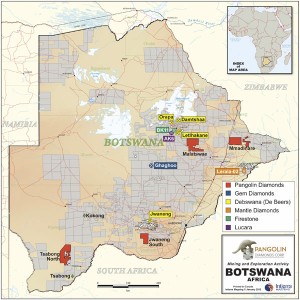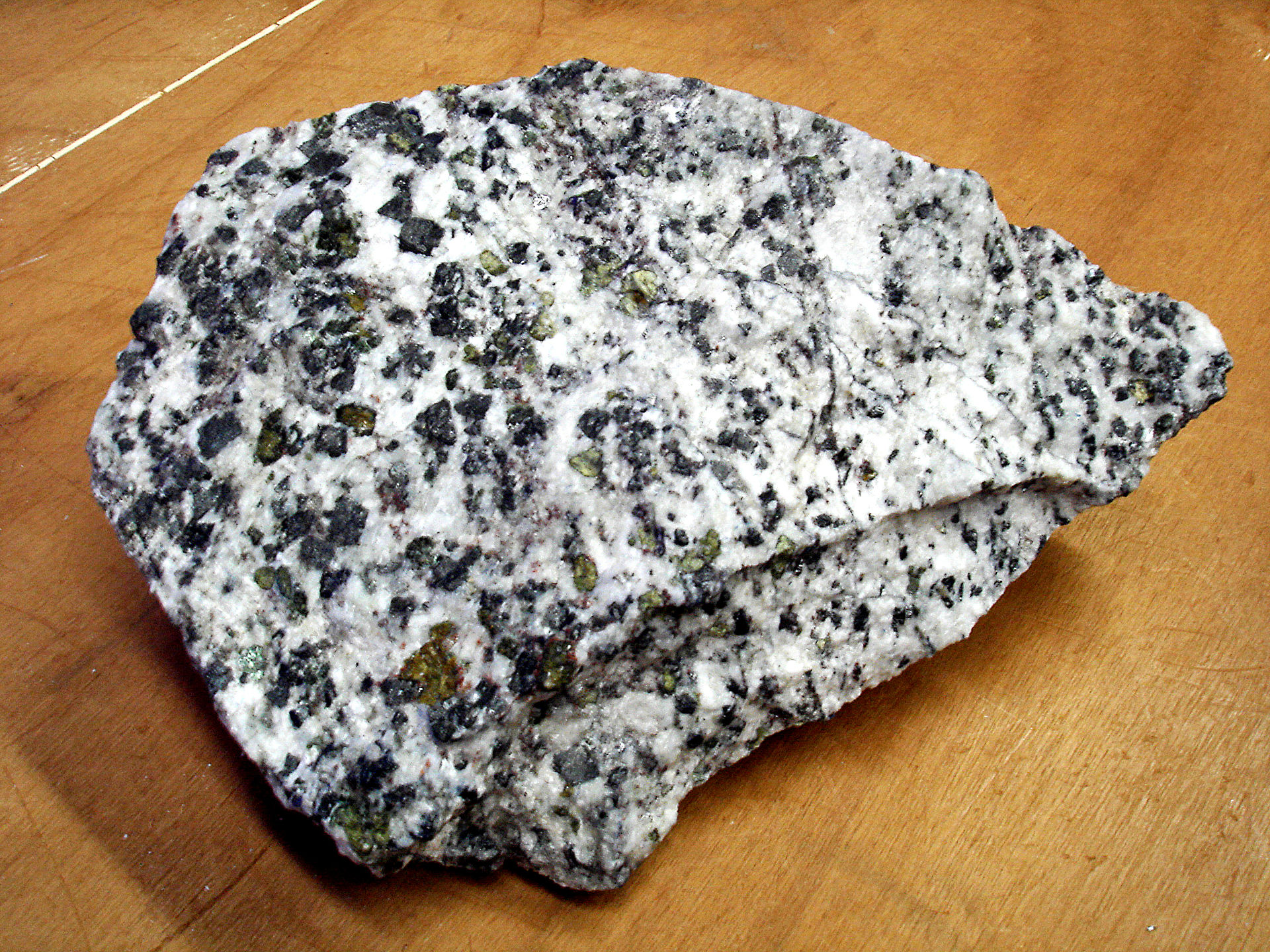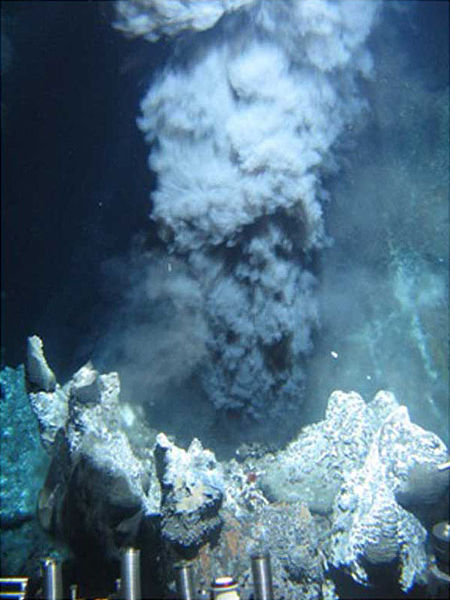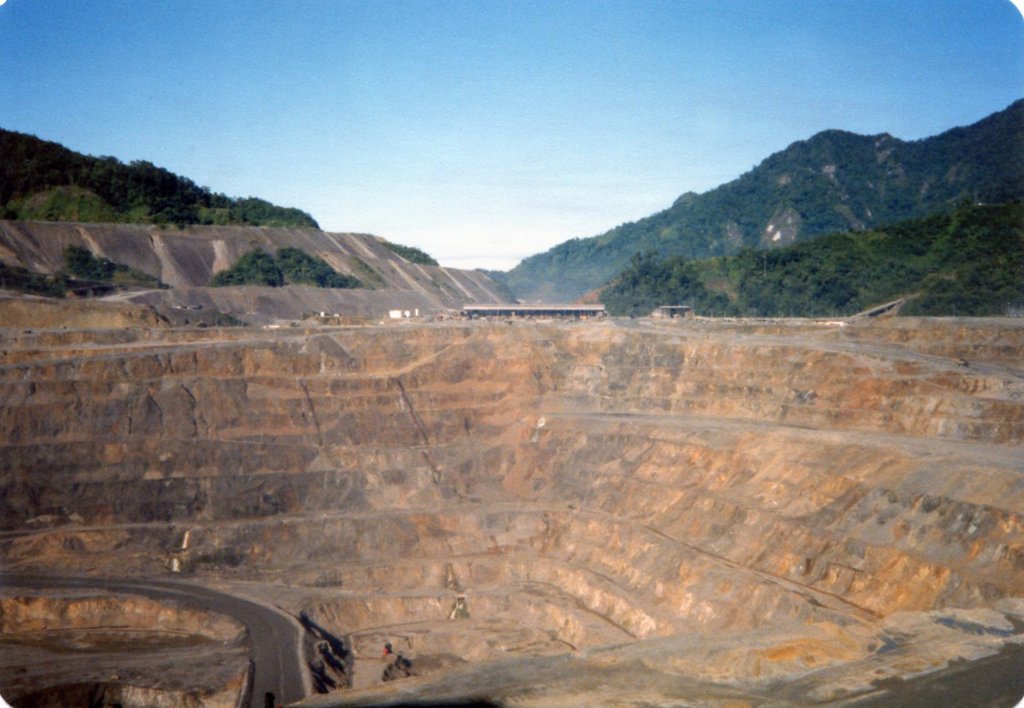It takes an incredible amount of money to prove up a diamond deposit. Pangolin will need to provide a constant string of successes to keep the money coming in and the project moving forward. That said, if things start to look really good a buyer will likely swoop in and take over.
[box type=”info” align=”aligncenter” ]Disclaimer: This is an editorial review of a public press release and may include opinions or points of view that may not be shared by the owners of geologyforinvestors.com or the companies mentioned in the release. The editorial comments are highlighted so as to be easily separated from the release text. Please view the full release here.[/box]
- Geophysical modeling suggests the Magi-Kimberlite at Pangolin’s Tsabong North Project in Botswana is a 270 hectare (2.7 km2) pipe
- Drilling intersects the kimberlite across 1,200 metres at an average 35 metres below surface
- New findings build on earlier discoveries at the same site: High pressure garnet indicators have previously been recovered 14 metres above the Magi-Kimberlite
- Two new kimberlite drill targets in Tsabong North, both more than 170 hectares (1.7 km2), have been identified by the geophysical modeling
TORONTO, ONTARIO–(Marketwired – Oct. 16, 2013) – Pangolin Diamonds Corp. (TSX VENTURE:PAN) (the “Company” or “Pangolin”) announced that it has discovered one of the largest kimberlites in the world, modeled at 270 hectares (2.7 km2), at its 100% owned Tsabong North Project (the “Project”) in Botswana.
[box type=”note” align=”aligncenter” ]Pangolin is a relatively new company (associated with the former Key Gold) that is focusing on several Kimberlite prospects in Botswana. Kimberlite’s are a volcanic rock derived from deep within the earth and may host economic deposits of diamonds. You don’t hear much about Botswana, but it produces the world’s highest quality diamonds. Geographically Botswana is directly north of South Africa. We have included a map of Pangolin’s projects below. [/box]

A number of the world’s largest kimberlites include:
- Se251 in Angola, measuring 220 hectares (2.2 km2)
- MK1 in Botswana, measuring 180 hectares (1.8 km2)
- Mwadui in Tanzania, measuring 146 hectares (1.46 km2)
Kimberlite Discovery
The new discovery stems from Pangolin’s discovery earlier this year of two kimberlites, Magi-01 and Magi-02, at its Tsabong North Project.
Aeromagnetic data on those finds was submitted by Pangolin for independent review by Mr. Billy Steenkamp, of Xcalibur Airborne Geophysics of Pretoria, South Africa. Mr. Steenkamp is a Qualified Person under National Instrument 43-101 rules. His observations include the following:
- The previously reported Magi kimberlites are part of a single intrusive complex with a total surface area estimated at 270 Hectares (2.7 km2):
- Some of the selected intrusive kimberlite targets could be of syn- or pre-Karoo age; and
- Two new kimberlite drill targets have been identified with total intrusive areas modeled at 170 Hectares (1.7 km2) and 175 Hectares (1.75 km2).
[box type=”note” align=”aligncenter” ]Kimberlites may contain magnetic iron oxides such as magnetite and ilmenite. An airborne magnetic survey for kimberlites would look for a small circular magnetic anomaly caused by these minerals. Depending on the background magnetics they may or may not contrast from the host rock. In addition, they are generally less dense than the surrounding bedrock and airborne geophysics can be used identify this density contrast as a gravity low.
One of the biggest challenges is the very small size of kimberlite pipes. Note that this and the other “world’s largest” kimberlites are only a few kilometers across. From an exploration standpoint these are needles in the haystack.
[/box]
Based on these observations, Pangolin drilled a new hole between the Magi-01 and Magi-02 kimberlites. The new hole positively intersected the same sandy tuffs recognized in the two previous drill holes, confirming that the Magi-Kimberlite is a single large body and not two smaller kimberlites as previously believed.
The Magi-Kimberlite has now been confirmed over a distance of 1,200 metres in an East-West direction. The average depth of intersection of the crater facies sediments is approximately 35 metres. The depths of intersection of the sandy tuffs vary between 55.3 and 61.5 metres.
Further work will begin shortly; seven additional holes have been laid out for core drilling to determine the final size of the Magi-Kimberlite. These core holes will also be used towards modeling the complex geology of the crater sediments and kimberlitic sandy tuffs in preparation for future possible larger diameter drilling. Each hole will intersect at least 100 metres of kimberlite to recover any additional indicator minerals, and any diamonds. One hole will be drilled to a minimum depth of 250 metres of kimberlite intersection.
Detailed logging of the core indicates that the Magi-Kimberlite is of syn-Karoo age. This makes it older than the Cretaceous diamondiferous kimberlites of the Tsabong kimberlite field further to the south, dated at 78 million years, but potentially similar in age to the Jwaneng kimberlites, dated at 245 million years.
[box type=”note” align=”aligncenter” ]These projects are still in their early stage. Basically, some kimberlite targets were identified by geophysical surveys and confirmed with some test drilling. The size of the kimberlite is inferred from the geophysical modelling.
Pangolin’s next step will be more intensive drilling and assaying for indicator minerals and diamonds in their kimberlite finds. [/box]
Core samples from all the holes are being submitted to independent laboratories to recover any additional indicator minerals, and any diamonds. High pressure garnets originating deep in the earth’s mantle have previously been recovered from the Magi-1/1 drill core, 14 metres above the surface of the Magi-Kimberlite.
Dr Leon Daniels, PhD, Chairman of the Board of Pangolin, stated: “The geophysical models available to Pangolin strongly suggest the potential for discovering additional very large kimberlites in the Tsabong North Project area.”
About the Tsabong North Project
The Tsabong North Project, located approximately 100 km north of the town of Tsabong in south-western Botswana, is 1,545 km2 in size. It is comprised of anomalous concentrations of kimberlite indicators and has large geo-botanical features. Pangolin has identified more than 50 drill-ready aeromagnetic targets in the Project area, several of which have surface areas exceeding 20 Hectares (0.2 km2).
[box type=”note” align=”aligncenter” ]Geobotany is the use of vegetation to distinguish or determine subsurface geology or changes in the geology. The “geobotanical feature” they refer to is a vegetation contrast from the surrounding landscape. Since deep sourced volcanic rocks such as kimberlite are low in silica they break down more easily resulting in thicker higher quality overlying soils. This is why many farmers risk planting near active volcanoes. In the case of these kimberlites, the thicker vegetation contrasts from the surrounding savannah. The satellite photo below from Pangolin’s Jwaneng South prospect clearly shows this type of contrast. [/box]
[googlemap src=”https://maps.google.com/?ll=-24.99217,24.62248&spn=0.09452,0.053473&t=h&z=14″ width=”300″ height=”300″ align=”alignleft” ]
The Tsabong North Project is situated on the margin of the Archaean Kaapvaal Craton in a similar tectonic environment to the Orapa kimberlite field. The 45 mantle-derived garnets inclusive of the high pressure garnets were discovered in the drill core Magi-01/01. These garnets are very similar in chemical composition to the garnets from the Letlhakane Mine in the Orapa area.
Pangolin’s soil sampling has produced highly anomalous concentrations of kimberlite indicators within the Project area. Microprobe analyses of indicator minerals have confirmed the presence of G10 garnets, indicating the presence of a mantle conducive to the crystallization of diamonds. A number of indicators occur, including remnants of kelyphite that indicate close proximity to kimberlite. Enzyme-leach trace element results are consistent with orientation trace element results over known kimberlites near the Project.
The Company cautions that information regarding the Se251, MK1, Mwadui, and Orapa kimberlites, and Letlhakane Mine or Orapa Mine, are not necessarily indicative of the kimberlite or kimberlite targets being drilled by the Company. The Company further cautions that there is no guarantee that the kimberlite and/or kimberlite targets being drilled by the Company will return diamond results of any economic significance.
About Pangolin Diamonds Corp.
Pangolin Diamonds Corp. is building a leading diamond exploration and development company in the heart of Botswana, the world’s leading diamond producing country by value. The Company is the 100% owner of 9 Prospecting Licences encompassing the Tsabong North, Jwaneng South, Malatswae and Mmadinare Projects. Pangolin’s management and team leaders have over 135 years of combined diamond exploration experience in southern Africa. This makes the Company the most experienced diamond explorer in Botswana other than De Beers Exploration and Debswana. The Company is equipped for exploration, with two diamond drill rigs and a fully portable one-tonne per hour Dense Media Separation Plant used to prepare samples and make diamond concentrates. Pangolin is well-funded to continue its exploration programs for the next year.
[box type=”note” align=”aligncenter” ]It takes an incredible amount of money to prove up a diamond deposit. Pangolin will need to provide a constant string of successes to keep the money coming in and the project moving forward. That said, if things start to look really good a buyer will likely swoop in and take over. A risky business to be sure, but the rewards can be very nice.[/box]
The technical disclosure in this news release has been reviewed and approved by Dr. Leon Daniels, Ph.D., Member of AIG, Chairman of the Board of Pangolin, and Manfred R Marx, B.Sc., Diploma Environmental Sciences. Both are Qualified Persons under National Instrument 43-101 rules.
For more information on Pangolin Diamonds Corp, please refer to www.pangolindiamondscorp.com.
Neither the TSX Venture Exchange nor its Regulation Services Provider (as that term is defined in the policies of the TSX Venture Exchange) accepts responsibility for the adequacy or accuracy of this release.
[box type=”success” align=”aligncenter” ]Have a company or release you’d like us to look at? Let us know though our contact page, through Google+, Twitter or Facebook.[/box]






